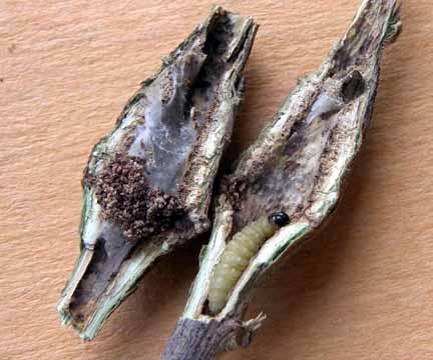Caterpillars of the goldenrod gall moth, Epiblema scudderiana (Clemens) (Lepidoptera, Olethreutidae), inhabit elliptical galls on the stems of goldenrod (Solidago sp.). The life cycle of Epiblema is much the same as that of Eurosta. Females lay eggs on the growing tips of goldenrod in the late spring and after hatching the caterpillar bores into the stem and starts to eat. The plant-insect interaction leads to the formation of an elliptical gall with wood-grain like scars on the outside, offering much better camouflage than the ball gall of Eurosta. In the autumn, the fifth (and final) instar of the caterpillar gets ready for winter. It moves out of the main gall cavity, hollows out the stem below the gall and fits itself snugly and vertically into this space in a head up position. The caterpillar lines the interior of the stem and gall with silk which helps to act as a barrier to water or ice penetration. Epiblema uses the freeze avoidance strategy of cold-hardiness and by mid-winter the larvae in the Ottawa, Canada area can supercool to ‑38°C before freezing. To keep from freezing the larvae break down huge quantities of glycogen (built up from summer eating) and converted this into ultrahigh concentrations of glycerol -- indeed, in midwinter, as much as 18-20% of their total body mass is glycerol.

This provides antifreeze protection to their body fluids in the same way as ethylene glycol protects an automobile radiator. The larvae probably also produce antifreeze proteins, as do other freeze-avoiding insects. Epiblema larvae also enter diapause (a state of arrested development and hypometabolism) that lasts for 3-4 months during midwinter. Subsequently, a low rate of development is reinitiated and accelerates quickly when temperatures warm in the spring leading to pupation. Adult moths hatch in late spring and the cycle begins again.